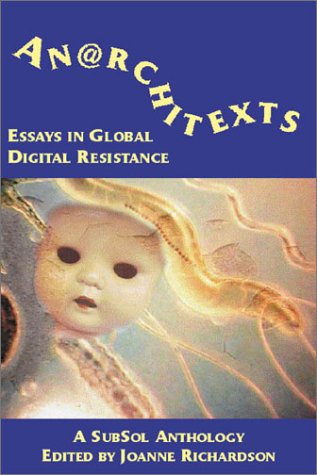Geert Lovink: Dark Fiber: Tracking Critical Internet Culture (2002)
Filed under book | Tags: · activism, cyberculture, internet, media, media activism, media theory, net art, net criticism, network culture, networks, politics, tactical media

“According to media critic Geert Lovink, the Internet is being closed off by corporations and governments intent on creating a business and information environment free of dissent. Calling himself a radical media pragmatist, Lovink envisions an Internet culture that goes beyond the engineering culture that spawned it to bring humanities, user groups, social movements, nongovernmental organizations (NGOs), artists, and cultural critics into the core of Internet development.
In Dark Fiber, Lovink combines aesthetic and ethical concerns and issues of navigation and usability without ever losing sight of the cultural and economic agendas of those who control hardware, software, content, design, and delivery. He examines the unwarranted faith of the cyber-libertarians in the ability of market forces to create a decentralized, accessible communication system. He studies the inner dynamics of hackers’ groups, Internet activists, and artists, seeking to understand the social laws of online life. Finally, he calls for the injection of political and economic competence into the community of freedom-loving cyber-citizens, to wrest the Internet from corporate and state control.
The topics include the erosion of email, bandwidth for all, the rise and fall of dot-com mania, techno-mysticism, sustainable social networks, the fight for a public Internet time standard, the strategies of Internet activists, mailing list culture, and collaborative text filtering. Stressing the importance of intercultural collaboration, Lovink includes reports from Albania, where NGOs and artists use new media to combat the country’s poverty and isolation; from Taiwan, where the September 1999 earthquake highlighted the cultural politics of the Internet; and from Delhi, where a new media center explores free software, public access, and Hindi interfaces.”
Publisher MIT Press, 2002
ISBN 0262621800, 9780262621809
382 pages
Reviews: McKenzie Wark (Rhizome, 2002), Lisa Nakamura (Mute, 2002), Franco Berardi Bifo (Generation Online, n.d.), Catriona Mills (M/C Reviews), Christina Van Houten (Rhizomes, 2009), Kirk McElhearn (Technology & Society, n.d.), Evangelos Milios (Social Science Computer Review, 2003), Arnold Peskin (Journal of Urban Technology, 2003).
PDF (added on 2018-10-24)
Comments (3)Rita Raley: Tactical Media (2009)
Filed under book | Tags: · disobedience, hacktivism, media art, subversion, tactical media

“Tactical media describes interventionist media art practices that engage and critique the dominant political and economic order. Rather than taking to the streets and staging spectacular protests, the practitioners of tactical media engage in an aesthetic politics of disruption, intervention, and education. From They Rule, an interactive map of the myriad connections between the world’s corporate and political elite created by Josh On and Futurefarmers, to Black Shoals, a financial market visualization that is intended to be both aesthetically and politically disruptive, they embrace a broad range of oppositional practices.
In Tactical Media, Rita Raley provides a critical exploration of the new media art activism that has emerged out of, and in direct response to, postindustrialism and neoliberal globalization. Through close readings of projects by the DoEAT group, the Critical Art Ensemble, Electronic Civil Disobedience, and other tactical media groups, she articulates their divergent methods and goals and locates a virtuosity that is also boldly political. Contemporary models of resistance and dissent, she finds, mimic the decentralized and virtual operations of global capital and the post-9/11 security state to exploit and undermine the system from within.”
Emphasizing the profound shift from strategy to tactics that informs new media art-activism, Raley assesses the efficacy of its symbolic performances, gamings, visualizations, and hacks. With its cogent analyses of new media art and their social impact, Tactical Media makes a timely and much needed contribution to wider debates about political activism, contemporary art, and digital technology.
Publisher University of Minnesota Press, 2009
ISBN 0816651515, 9780816651511
208 pages
PDF (updated on 2021-1-13)
Comment (0)Joanne Richardson (ed.): An@rchitexts: Voices from the Global Digital Resistance (2005)
Filed under book | Tags: · activism, cultural resistance, floss, gift economy, mass media, net art, networks, social movements, tactical media

“An@rchitexts brings together a global mix of voices from the new ‘underground’: engaged artists intervening in local struggles on the streets, media producers promoting technologies based on sharing and cooperation rather than privatization and competition, activists participating in global networks built through electronic democracies and decentralized forms of cooperation, and extraordinary people creating an alternative society through their everyday practices.
As a matter of principle An@rchitexts reflects the first-hand perspective of those involved at the point of production, not distanced reflections by critics, specialists, or armchair theorists.”
Publisher Autonomedia, 2005
ISBN 1570271429, 9781570271427
368 pages
PDF (13 MB, no OCR, some pages missing, updated on 2019-11-7)
Comment (0)
